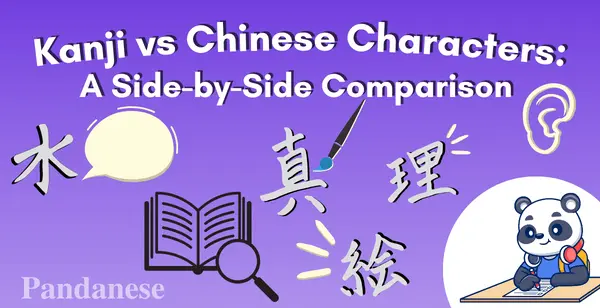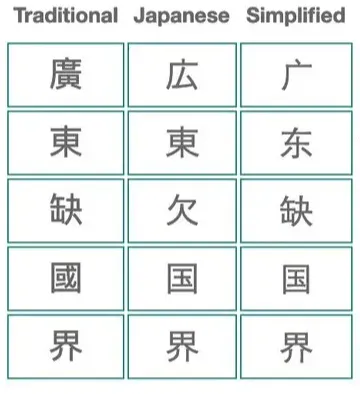
Kanji vs Chinese Characters: A Side-by-Side Comparison
At first glance, Chinese and Japanese writing systems may appear similar with their elegant and aesthetically pleasant characters. However, you’ll find several differences if you know a little bit of one or both languages.
First, the only Japanese characters that share a relationship with Chinese characters are kanji. Additionally, hiragana and katakana are two phonetic syllabic alphabets peculiar to the Japanese language.

Kanji vs Hiragana vs Katakana for the name Satoshi, Actual Fluency
Kanji is the most complex part of Japanese writing; they are derived from Chinese, and there are thousands of them. The most commonly used ones are about 1500.
We’ll look at kanji and Chinese characters from various points of view.
Let’s start!
What is the history of Chinese characters?
More than 6,000 years ago, the earliest known form of Chinese writing was first invented in a small village near the Yellow River Valley.
Early Chinese writing shows a fundamentally pictographic origin, which means in the early stages of its development, it is clear that the main mechanism for creating characters was to draw a picture of what was intended to be represented. At that time, ancient Chinese people used writings to communicate with the spiritual realm, pray for blessings, and seek protection from the spirits.
They soon faced a problem: not all elements of the language could be easily represented in pictorial form—think of certain verbs or feelings. For this reason, the early creators of Chinese writing resorted to various other mechanisms. One was to use a more abstract representation.
The development from pictograms to ideograms used to convey abstract ideas occurred around A.D. 30–124. That’s when the first dictionary of Chinese was finally compiled.
As of today, the Chinese writing system still maintains a strong connection between the image of the original objects and the written characters. It never developed an alphabet, and that’s one of the reasons why we find Chinese so poetic and fascinating.
What is the history of kanji?
The Japanese language developed a systematized writing system quite late in its history: the importation of Chinese writing in the Asuka (552–646 A.D.) and Nara (646–794 A.D.) periods was crucial.
In the early period of kanji's history, there was no significant difference between Kanji and Chinese characters apart from the pronunciation. It’s like the Japanese language took Chinese characters and started reading them differently, but it works the same as in Chinese.
But, adapting the complex Chinese writing system to a different language took a lot of work. If you think about it, there probably were words or particles in Japanese that didn’t have an exact translation in the Chinese language, and therefore there wasn’t a specific Chinese character that could be used.
For this reason, Japanese people started changing the character's meanings and invented new kanji. So, the two alphabets mixed and mingled into a new writing system with rules specific to its own language.
What are the similarities between kanji vs Chinese characters?
1. Nouns
Nouns are a person, place, or thing, and these words share the biggest similarities between Japanese and Chinese words. Kanji and Chinese characters used to express nouns are similar in form and structure.
Let’s see a couple of examples:
a) No gendered nouns
First, Chinese and Japanese nouns do not have gender (masculine or feminine forms)—if you speak French or Italian, you know what I’m talking about! And there’s more: Japanese and Chinese nouns usually do not have a singular or plural form.
That’s good news if we consider how simple it is to use Chinese and Japanese nouns and how little time it will take us to learn them.
b) A lot of interpretation
However, that means that Japanese and Chinese nouns do not carry much information with them: there’s a high degree of vagueness, and context is crucial to interpret the meaning.
This vagueness can cause some problems when translating, but at the end of the day, Asian and European languages are very different, and you cannot expect them to work the same way.
2. Numbers
Even though numbers have different pronunciations in Japanese and Chinese, in written language, kanji and Chinese characters representing numbers are the same.
Number |
Character |
Chinese Pronunciation |
Japanese Pronunciation |
one |
一 |
yī |
ichi |
two |
二 |
èr |
ni |
three |
三 |
sān |
san |
four |
四 |
sì |
yon / yo |
five |
五 |
wǔ |
go |
six |
六 |
liù |
roku |
seven |
七 |
qī |
nana / shichi |
eight |
八 |
bā |
hachi |
nine |
九 |
jiǔ |
kyuu / ku |
ten |
十 |
shí |
juu |
hundred |
百 |
bǎi |
hyaku |
thousand |
千 |
qiān |
sen |
Ten thousand |
万 |
wàn |
man |
Number character comparison: Chinese vs Japanese pronunciation
That’s good news if you are new to Chinese and already know Japanese numbers, or vice versa.
What are the differences between kanji and Chinese characters
1. Different simplification systems
a) Chinese simplification system
If you are familiar with Chinese dialects or have listened to Chinese speakers from different parts of China, you’ll know that numerous dialects use the same hanzi but pronounce them differently.
Numerous Chinese dialects exist because of Standard Chinese or Putonghua, also commonly referred to as Mandarin, which comes from a recent language reform that attempted to unify China linguistically through the "simplification" of hanzi.
Here are a couple of examples of simplified Chinese characters:
語 became语
說 became说
話 became话

Traditional vs simplified Chinese strokes, MSL Master
Nearly 2,000 traditional Chinese characters were modified through the reforms.
Nowadays, simplified Chinese characters are used in mainland China, Singapore, and Malaysia. However, people in Hong Kong, Taiwan, and Macau still use the traditional Chinese writing system.
b) Japanese simplification system
Regarding the Japanese traditional writing system, similar to the Chinese writing system, the traditional kanji were very complex. Moreover, despite having identical meanings, several characters were written differently from each other, making things even more complicated.
After World War II, the Japanese language underwent a simplification process as well: the Japanese government started to reduce the number of kanji by choosing the most common ones and simplifying them by reducing the strokes.
It is important to know that the Japanese language does not use simplified Chinese radicals but its own simplification system, known as shinjitai (新字体). For this reason, even though traditional kanji and Chinese characters are the same, simplified versions of both Japanese and Chinese languages are quite different.

Traditional Chinese vs Japanese vs simplified Chineses, Daijiro Wachi☔
For example, the traditional Chinese character 圖(drawing) was simplified to 图, while in Japanese kanji, it was simplified to “図.” Or, the traditional character 鐵 (iron) was modified into 铁 in simplified Chinese and 鉄 in simplified Japanese.
Most of the time, the simplified Japanese version is more intricate than the corresponding Chinese one.
2. Kanji and Chinese characters with different meanings: False cognates
False cognates—commonly called “false friends”—are words that sound and could be spelled similarly, but have very different meanings. So, some characters are written the same in both languages but refer to two different concepts.
For example, kega in Japanese describes an ‘injury’ and can be written in hiragana, katakana, or kanji. In this case, the character for this word is used phonetically and not for its actual meaning, which is "blame me" in Chinese.
You can find other examples below:
Character |
Japanese meaning |
Chinese meaning |
怪我 |
injury |
blame me |
勉強 |
study |
adjective meaning inadequate, unconvincing, strained, far fetched, reluctantly |
不勉強 |
idleness, lac of application, lazy study habits, inactivity |
it’s alright, I dont force my way |
先生 |
teacher |
Mr. / mister |
切手 |
stamp |
to cut hands |
急行 |
express train |
urgently walking |
上手 |
skillful, proficient, expert |
Start to get familiar with, get to know how to do something |
下手 |
unskillful, awkward, inept, untrained |
proceed, start to do something, commence |
天井 |
ceiling , ceiling rpice, top price |
patio, roof frame, atrium, small yard; courtyard, skylight |
娘 |
daughter, offspring |
mother |
湯 |
hot water, hot spring |
soup |
有難う |
thank you |
trouble, catastrophic, disastrous, calamitous |
吃る |
to stutter, to stammer |
to eat |
邪魔 |
to distrub, to come in one’s way, an obstacle |
demon, devil |
文句 |
complaint |
sentence flow |
丈夫 |
strong, robust, durable |
husband |
大丈夫 |
ok, alright |
gentleman, man of honor |
演出 |
To direct, to produce (a play) |
to perform, to act (in movie/drama/show) |
Examples of false cognates between Japanese and Chinese
Beware of these false friends if you’re a speaker of both languages or aim to be one!
3. Names
While there are usually two (or at most three) characters in Chinese names, it is common that Japanese names consist of up to four characters. Additionally, kanji names can sometimes cause misunderstandings between Chinese and Japanese speakers.
For instance, the Japanese word “Abiko,” written 我孫子 in kanji, is just the name of a place in Japan. However, in Chinese, 我孫子 is pronounced “wo sunzi,” meaning “my grandchild.” If a Japanese person tried to write “I come from Abiko” in Chinese, it then would turn out to be: 我来自我孫子.
A Chinese speaker would be confused reading this sentence because they may think it means, “I come from my grandchild.”
4. Pictographs
Chinese writing originated as an attempt to create pictures of specific objects and actions, resulting in many pictographs.
Even though the original pictographic form is still present in the Japanese writing system, kanji characters are just a way of writing the Japanese pre-existing verbal form. Japanese kanji characters are meant to express and visualize the sounds of a language that was oral before it was written.
That’s how the Chinese culture contributed to the Japanese writing system: helping the Japanese write what was already being spoken.
That’s why Japanese also has other writing systems: hiragana and katakana.
If you think about it, that’s quite obvious: if we had to write English using Chinese characters, we would have to add many new elements.
5. Made-in-Japan kanji characters
Kokuji are kanji created by Japanese speakers: these kanji are mostly composed of two or more elements combined to create a new meaning.
For example, the kanji meaning "to work," 働, is composed of the radical of person 亻 and the kanji of action/movement 動. The idea is to represent "a person in action" that is working.
These types of compound kanji that express an idea are called "meaning compounds."
The earliest kokuji date back to the Nara era (8th century A.D.). For example, one of Japan's oldest collection of poems, the kanji for "sardine" 鰯 (いわし iwashi, 魚 fish + weak 弱) appeared for the first time.
However, if there were already many Chinese hanzi, why was it necessary to invent new ones?
In general, most kanji are phonetic compounds, which means they contain one element indicating pronunciation plus another indicating meaning. An example of a phonetic compound is the kanji 時 (time): the 寺 (temple) part is phonetic, giving the kanji the reading on "ji," while 日 (day) has to do with the general meaning of the kanji.
But, more was needed to import Chinese characters according to their pronunciation to represent Japanese origin. Therefore, creating kanji that expressed some meanings more logically through its components was easier.
Usually, kokuji possess "kun" readings (Japanese reading), apart from a few cases where they also have "on" readings (Chinese reading). In a few other cases, kokuji only have an on-reading and no kun-reading.
Kokuji mainly relates to plant and animal names, often referring to species that do not exist in China.
Although many kokuji are infrequent, it may be useful to know them to read some older pieces.
Here’s a list of kokuji.
Frequently asked questions
Are Japanese kanji Chinese characters?
Yes. Traditional Japanese kanji is the same as traditional Chinese characters. However, simplified Japanese Kanji (shinjitai) and simplified Chinese characters can be written differently and have different translation.
What is the similarities between Japanese and Chinese characters?
Traditional Japanese kanji share the same characters as traditional Chinese characters. Besides the character, nouns do not have genders, and their number counting system is similar. Additionally, in both languages, there is a lot of interpretation that is needed to understand the context.
What is the differences between Japanese and Chinese characters?
1. Their simplification system are different
2. Even though their share the same characters, they might have different meaning
3. Their naming system can be confusing for both native speakers
4. Their writing system differs: Chinese uses Chinese characters while Japanese uses kanji, hiragana, and katakana
5. Japan has made their own characters that does not exist in the Chinese writing system.
In closing
Chinese and Japanese languages are both very fascinating, especially for language learners—particularly in terms of writing systems.
The two languages share some history and characteristics, which has a poetic feeling. However, if we look at Chinese and Japanese languages more closely and with a more conscious approach, differences and links to each State's culture start to appear.
Hopefully, this article helped you understand the main common features and differences between Chinese characters and Japanese kanji.
As a Chinese language learner with a very basic knowledge of Japanese, it's impossible to tell which of the two languages is easier.
I noticed that the Chinese writing system has a higher degree of uniformity—there's just a way to write a word, no alphabets, and a less defined and simpler grammatical structure.
On the other hand, Japanese is more complicated in terms of alphabet and grammar. However, the number of characters in Japanese is smaller if you count the most common kanji.
In Chinese, the number of characters is huge and can easily overwhelm learners. Learning Chinese characters, however, is possible if you set your mind to it and use various techniques and materials, such as Pandanese, a learning platform that aims for users to master 6,000 hanzi Chinese characters a year for school, business, and travel.
Elisa Felici has been studying Chinese since 2014. She started her language-learning journey at Italian universities and lived in Beijing while attending Beijing’s Confucius Institute. Elisa passed HSK 4 and 5 and finally, in 2020, HSK 6. She now has a Master’s degree in translation and interpreting and has experience not only as a language learner but also as a Chinese teacher and translator.
The easiest way to learn Chinese & build vocabulary

